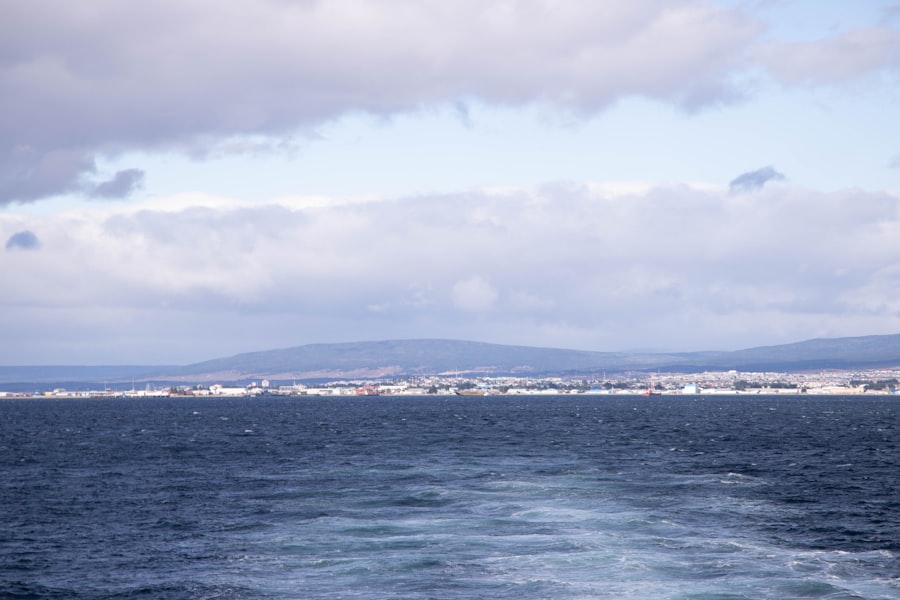The Drake Passage and the Strait of Magellan are two of the most significant maritime routes in the southern hemisphere, each with its own unique characteristics and historical importance. The Drake Passage, located between the southern tip of South America and Antarctica, is renowned for its turbulent waters and unpredictable weather. It serves as a critical conduit for vessels traveling to and from the Antarctic region, making it a focal point for scientific research and exploration.
In contrast, the Strait of Magellan, situated further north, offers a sheltered passage through the archipelago of Tierra del Fuego. This strait has historically provided a safer alternative to the open seas of the Drake Passage, allowing ships to navigate between the Atlantic and Pacific Oceans. Both waterways have played pivotal roles in maritime history, shaping trade routes and influencing exploration.
The Drake Passage, named after the English explorer Sir Francis Drake, is often regarded as one of the most challenging sea routes due to its strong currents and rough seas. Meanwhile, the Strait of Magellan, named after the Portuguese explorer Ferdinand Magellan, has been a vital passage for centuries, facilitating navigation for explorers and traders alike. Together, these two waterways represent not only geographical challenges but also a rich tapestry of human endeavor and exploration.
Key Takeaways
- The Drake Passage and the Strait of Magellan are two important waterways connecting the Atlantic and Pacific Oceans, with the former being the shortest route between Antarctica and South America.
- The Drake Passage and the Strait of Magellan have played significant roles in the exploration and colonization of the Americas, with the latter being the route used by Ferdinand Magellan during the first circumnavigation of the globe.
- The Drake Passage is known for its rough seas, strong winds, and unpredictable weather, making it one of the most challenging waterways to navigate.
- The Strait of Magellan is characterized by its narrow and winding channels, strong tidal currents, and unpredictable weather, posing challenges for navigation.
- Navigating the Drake Passage requires careful consideration of the prevailing weather patterns, including the notorious westerly winds and the potential for rapidly changing conditions.
Historical significance of the Drake Passage and Strait of Magellan
The historical significance of the Drake Passage cannot be overstated. It was first traversed by European explorers in the late 16th century, with Sir Francis Drake being one of the first to navigate its treacherous waters. His journey marked a turning point in maritime exploration, as it opened up new routes for trade and communication between Europe and the Americas.
The passage became a crucial link for whalers, sealers, and later, scientific expeditions to Antarctica. Its reputation for perilous conditions has made it a subject of fascination for adventurers and historians alike. On the other hand, the Strait of Magellan has been a vital maritime route since its discovery in 1520 by Ferdinand Magellan during his circumnavigation of the globe.
This strait allowed ships to avoid the hazardous waters around Cape Horn, providing a safer passage for trade and exploration. Over the centuries, it has served as a strategic point for naval operations and has been integral to the development of shipping routes in South America. The strait’s historical importance is further underscored by its role in connecting various cultures and economies across continents.
Geographical features and challenges of navigating the Drake Passage

The geographical features of the Drake Passage are defined by its vast expanse of open water, which stretches approximately 800 kilometers (500 miles) between Cape Horn and Antarctica. The passage is characterized by deep oceanic trenches and strong currents that can create formidable waves, often exceeding 10 meters (33 feet) in height. These conditions pose significant challenges for navigators, as vessels must contend with rapidly changing weather patterns and unpredictable swells.
Navigating the Drake Passage requires not only skill but also an understanding of its unique geographical features. The convergence of cold Antarctic waters with warmer currents from the north creates an environment ripe for storms and turbulence. Mariners must be prepared for sudden shifts in wind direction and intensity, which can lead to dangerous situations at sea.
The passage’s remoteness adds another layer of complexity; with limited access to ports or safe havens, vessels must be self-sufficient and well-equipped to handle emergencies.
Geographical features and challenges of navigating the Strait of Magellan
| Geographical Features and Challenges of Navigating the Strait of Magellan | |
|---|---|
| Width | Wide, ranging from 2 to 31 miles |
| Length | Approximately 350 miles |
| Currents | Strong tidal currents and unpredictable winds |
| Weather | Variable weather conditions, including fog and strong winds |
| Navigation Challenges | Narrow channels, rocky shores, and potential for icebergs |
| Historical Significance | Important route for early explorers and trade expeditions |
In contrast to the open waters of the Drake Passage, the Strait of Magellan is characterized by a series of narrow channels and islands that create a more sheltered environment for navigation. Stretching approximately 570 kilometers (350 miles), this strait is dotted with numerous islands, fjords, and rocky outcrops that can complicate navigation. While these features provide some protection from harsh weather conditions, they also require mariners to be vigilant and skilled in piloting through tight passages.
The challenges of navigating the Strait of Magellan include strong tidal currents and shifting winds that can create hazardous conditions for vessels. The strait’s intricate geography demands precise navigation techniques, as even minor miscalculations can lead to grounding or collisions with submerged rocks. Additionally, fog can frequently obscure visibility, further complicating navigation efforts.
Despite these challenges, many sailors prefer the Strait of Magellan for its relative safety compared to the open waters of the Drake Passage.
Weather conditions and their impact on navigating the Drake Passage
The weather conditions in the Drake Passage are notoriously volatile, making it one of the most challenging maritime environments in the world. The region is subject to fierce storms that can arise with little warning, driven by the confluence of cold Antarctic air masses and warmer air from the north. These storms can produce high winds, heavy rain, and rough seas that pose significant risks to vessels attempting to cross.
Navigators must be acutely aware of weather forecasts and patterns when planning a crossing through the Drake Passage. The ability to read changing weather conditions is crucial for ensuring safety at sea. Mariners often rely on advanced technology and satellite communications to monitor real-time weather updates, allowing them to make informed decisions about their route and timing.
Understanding seasonal variations is also essential; summer months may offer calmer conditions compared to winter when storms are more frequent.
Weather conditions and their impact on navigating the Strait of Magellan

While the weather conditions in the Strait of Magellan are generally milder than those in the Drake Passage, they can still present challenges for navigators. The strait experiences a temperate maritime climate characterized by frequent rain and strong winds. Sudden squalls can occur, particularly during transitional seasons like spring and autumn, leading to reduced visibility and rough seas.
Navigators must remain vigilant when sailing through the Strait of Magellan, as weather conditions can change rapidly. Fog is a common occurrence in this region, often limiting visibility to just a few meters. Mariners are advised to use radar systems and maintain a safe distance from shorelines and other vessels to avoid potential hazards.
Additionally, understanding local weather patterns can help sailors anticipate changes and adjust their navigation strategies accordingly.
Wildlife and marine life in the Drake Passage and Strait of Magellan
Both the Drake Passage and the Strait of Magellan are rich in biodiversity, hosting a variety of marine life that thrives in their unique ecosystems. The Drake Passage is particularly famous for its abundance of marine mammals, including whales such as humpbacks, orcas, and blue whales that migrate through these waters during feeding seasons. The nutrient-rich waters support an array of fish species, making it an essential feeding ground for seabirds like albatrosses and petrels.
In contrast, the Strait of Magellan is home to diverse wildlife adapted to its sheltered environment. Sea lions bask on rocky shores while penguins nest on nearby islands. The strait’s nutrient-rich waters also support various fish species that attract larger predators like seals and dolphins.
Birdwatchers flock to this region to observe unique avian species that inhabit its coastal areas.
Navigation tips and strategies for crossing the Drake Passage
Crossing the Drake Passage requires careful planning and preparation to ensure a safe journey. Mariners should begin by thoroughly researching weather forecasts and sea conditions before departure. Utilizing advanced navigation tools such as GPS systems can help track progress while providing real-time data on positioning relative to potential hazards.
It is also advisable for sailors to choose their crossing times wisely; many experienced mariners recommend attempting crossings during periods known for calmer weather patterns, typically during late spring or early summer months. Additionally, maintaining open communication with other vessels in the area can provide valuable insights into current conditions or potential dangers ahead.
Navigation tips and strategies for navigating the Strait of Magellan
Navigating through the Strait of Magellan requires a different set of strategies compared to crossing the Drake Passage due to its intricate geography. Mariners should familiarize themselves with detailed nautical charts that highlight key landmarks, navigational aids, and potential hazards such as submerged rocks or shallow areas. Utilizing local knowledge can be invaluable when traversing this strait; consulting with experienced sailors or local pilots who understand its unique challenges can enhance safety significantly.
Additionally, maintaining situational awareness is crucial; keeping an eye on changing weather patterns while monitoring other vessels will help ensure a smooth passage through this complex waterway.
Safety precautions and emergency protocols for sailing through the Drake Passage
Safety precautions are paramount when sailing through the Drake Passage due to its unpredictable nature. Mariners should ensure that their vessels are equipped with essential safety gear such as life jackets, flares, emergency beacons, and first aid kits before embarking on their journey. Conducting thorough safety drills with crew members can prepare everyone for potential emergencies.
In case of severe weather or emergencies at sea, having a well-defined emergency protocol is critical. This includes establishing communication channels with nearby vessels or coast guard services while having contingency plans in place for abandoning ship if necessary. Regularly reviewing these protocols ensures that all crew members are familiar with their roles during emergencies.
Safety precautions and emergency protocols for sailing through the Strait of Magellan
While navigating through the Strait of Magellan may present fewer dangers than crossing the Drake Passage, safety precautions remain essential. Mariners should ensure that their vessels are equipped with navigational aids such as radar systems or AIS (Automatic Identification System) devices to enhance situational awareness in this busy waterway. Establishing clear communication protocols among crew members is vital when sailing through narrow channels where visibility may be compromised due to fog or rain.
In case of emergencies such as grounding or collisions with other vessels, having an emergency response plan that includes evacuation procedures can help mitigate risks effectively. Regular safety drills will ensure that all crew members are prepared for any situation that may arise while navigating this complex strait. In conclusion, both the Drake Passage and Strait of Magellan offer unique challenges and opportunities for mariners exploring these storied waterways.
Understanding their historical significance, geographical features, weather conditions, wildlife diversity, navigation strategies, and safety protocols is essential for ensuring safe passage through these remarkable regions. Whether one chooses to brave the turbulent waters of the Drake Passage or navigate through the sheltered channels of the Strait of Magellan, preparation is key to a successful journey across these iconic maritime routes.
The Drake Passage and the Strait of Magellan are two of the most significant maritime routes in the Southern Hemisphere, each with its own unique challenges and historical importance. While the Drake Passage is known for its turbulent waters and is a key route for ships traveling between the Atlantic and Pacific Oceans, the Strait of Magellan offers a more sheltered passage but is narrower and more complex to navigate. For those interested in exploring more about these fascinating maritime routes and their geographical significance, you can find additional information on the MyGeoQuest sample page, which provides insights into various geographical wonders and their historical contexts.
WATCH NOW! Drake Passage: Earth’s Deadliest Waters Revealed
FAQs
What is the Drake Passage?
The Drake Passage is the body of water between the southern tip of South America and the northern tip of the Antarctic Peninsula. It connects the southwestern part of the Atlantic Ocean with the southeastern part of the Pacific Ocean.
What is the Strait of Magellan?
The Strait of Magellan is a navigable sea route in southern Chile, separating mainland South America to the north and Tierra del Fuego to the south. It is considered one of the most important natural passages in the world for navigation.
How are the Drake Passage and the Strait of Magellan related?
The Drake Passage and the Strait of Magellan are both important maritime routes for ships traveling between the Atlantic and Pacific Oceans. The Drake Passage is located further south and is known for its rough seas and strong winds, while the Strait of Magellan provides a more sheltered and historically significant alternative route.
What are the main challenges of navigating the Drake Passage?
The Drake Passage is known for its notoriously rough seas and strong winds, making it one of the most challenging maritime routes in the world. The area is also prone to rapidly changing weather conditions and is often subject to extreme cold temperatures.
What is the significance of the Drake Passage and the Strait of Magellan?
Both the Drake Passage and the Strait of Magellan have played crucial roles in the history of exploration and global trade. They have provided important sea routes for ships traveling between the Atlantic and Pacific Oceans, and have been integral to the development of maritime trade and exploration in the southern hemisphere.
